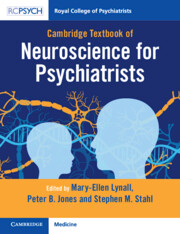Book contents
- Cambridge Textbook Of Neuroscience for Psychiatrists
- Reviews
- Cambridge Textbook of Neuroscience for Psychiatrists
- Copyright page
- Contents
- Contributors
- Introduction
- 1 Cells
- 2 Neurotransmitters and Receptors
- 3 Basic Techniques in Neuroscience
- 4 Neuroanatomy
- 5 Neural Circuits
- 5.1 Appetite
- 5.2 Sleep
- 5.3 Sex and Sex Hormones
- 5.4 Violence and Aggression
- 5.5 Nociception and Pain
- 5.6 The Motor System and Movement Disorders
- 5.7 Computational Models of Learning
- 5.8 Habit Formation
- 5.9 Reward, Pleasure and Motivation
- 5.10 Emotion
- 5.11 Perception
- 5.12 Attention
- 5.13 Apathy, Anhedonia and Fatigue
- 5.14 Memory
- 5.15 Fronto-Executive Functions
- 5.16 Empathy and Theory of Mind
- 5.17 Language
- 5.18 Brain Networks and Dysconnectivity
- 6 Modulators
- 7 Genetics
- 8 Neurodevelopment and Neuroplasticity
- 9 Integrated Neurobiology of Specific Syndromes and Treatments
- 10 Neurodegeneration
- Index
- References
5.9 - Reward, Pleasure and Motivation
from 5 - Neural Circuits
Published online by Cambridge University Press: 08 November 2023
- Cambridge Textbook Of Neuroscience for Psychiatrists
- Reviews
- Cambridge Textbook of Neuroscience for Psychiatrists
- Copyright page
- Contents
- Contributors
- Introduction
- 1 Cells
- 2 Neurotransmitters and Receptors
- 3 Basic Techniques in Neuroscience
- 4 Neuroanatomy
- 5 Neural Circuits
- 5.1 Appetite
- 5.2 Sleep
- 5.3 Sex and Sex Hormones
- 5.4 Violence and Aggression
- 5.5 Nociception and Pain
- 5.6 The Motor System and Movement Disorders
- 5.7 Computational Models of Learning
- 5.8 Habit Formation
- 5.9 Reward, Pleasure and Motivation
- 5.10 Emotion
- 5.11 Perception
- 5.12 Attention
- 5.13 Apathy, Anhedonia and Fatigue
- 5.14 Memory
- 5.15 Fronto-Executive Functions
- 5.16 Empathy and Theory of Mind
- 5.17 Language
- 5.18 Brain Networks and Dysconnectivity
- 6 Modulators
- 7 Genetics
- 8 Neurodevelopment and Neuroplasticity
- 9 Integrated Neurobiology of Specific Syndromes and Treatments
- 10 Neurodegeneration
- Index
- References
Summary
Rewards are crucial for individual and evolutionary survival and have three major functions: learning, approach (motivation, decision making) and emotion. Neurophysiological work in animals has elucidated neuronal mechanisms for learning and approach. Key brain centres for reward are dopamine neurons, the striatum, the orbitofrontal cortex and the amygdala, each of them interconnected and associated with other brain structures in which reward information is often processed in conjunction with sensory and motor mechanisms. Although it is difficult to make categorical functional distinctions between highly connected brain structures, some simplification is possible: dopamine neurons play a prime role in reinforcement learning and updating of economic decision variables; striatum neurons confer reward information to movements and decisions; the orbitofrontal cortex has a prime function in decisions; and the amygdala, classically known for fear processing, has a substantial role in reward processes suitable for economic decision making. Any disturbance in these crucial neuronal survival mechanisms has serious consequences for the welfare of individuals.
- Type
- Chapter
- Information
- Cambridge Textbook of Neuroscience for Psychiatrists , pp. 199 - 207Publisher: Cambridge University PressPrint publication year: 2023

